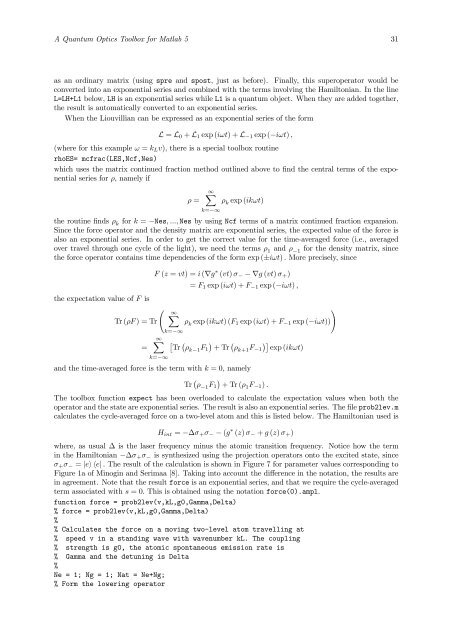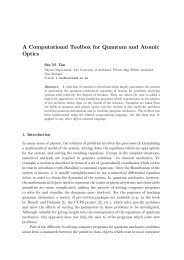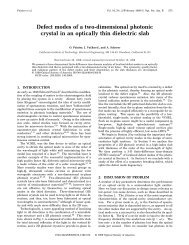A Quantum Optics Toolbox for Matlab 5
A Quantum Optics Toolbox for Matlab 5
A Quantum Optics Toolbox for Matlab 5
- No tags were found...
You also want an ePaper? Increase the reach of your titles
YUMPU automatically turns print PDFs into web optimized ePapers that Google loves.
A <strong>Quantum</strong> <strong>Optics</strong> <strong>Toolbox</strong> <strong>for</strong> <strong>Matlab</strong> 5 31as an ordinary matrix (using spre and spost, just as be<strong>for</strong>e). Finally, this superoperator would beconverted into an exponential series and combined with the terms involving the Hamiltonian. In the lineL=LH+L1 below, LH is an exponential series while L1 is a quantum object. When they are added together,the result is automatically converted to an exponential series.When the Liouvillian can be expressed as an exponential series of the <strong>for</strong>mL = L 0 + L 1 exp (i!t)+L ¡1 exp (¡i!t) ;(where <strong>for</strong> this example ! = k L v); there is a special toolbox routinerhoES= mcfrac(LES,Ncf,Nes)which uses the matrix continued fraction method outlined above to …nd the central terms of the exponentialseries <strong>for</strong> ½; namely if½ =1Xk=¡1½ k exp (ik!t)the routine …nds ½ k <strong>for</strong> k = ¡Nes; :::; Nes by using Ncf termsofamatrixcontinuedfractionexpansion.Since the <strong>for</strong>ce operator and the density matrix are exponential series, the expected value of the <strong>for</strong>ce isalso an exponential series. In order to get the correct value <strong>for</strong> the time-averaged <strong>for</strong>ce (i.e., averagedover travel through one cycle of the light), we need the terms ½ 1 and ½ ¡1 <strong>for</strong> the density matrix, sincethe <strong>for</strong>ce operator contains time dependencies of the <strong>for</strong>m exp (§i!t) : More precisely, sinceF (z = vt) =i (rg ¤ (vt) ¾ ¡ ¡rg (vt) ¾ + )= F 1 exp (i!t)+F ¡1 exp (¡i!t) ;the expectation value of F isà 1!XTr (½F )=Tr ½ k exp (ik!t)(F 1 exp (i!t)+F ¡1 exp (¡i!t))=1Xk=¡1k=¡1£ Tr¡½k¡1 F 1¢ +Tr¡½k+1 F ¡1¢¤ exp (ik!t)and the time-averaged <strong>for</strong>ce is the term with k =0; namelyTr ¡ ¢½ ¡1 F 1 +Tr(½1 F ¡1 ) :The toolbox function expect has been overloaded to calculate the expectation values when both theoperator and the state are exponential series. The result is also an exponential series. The …le prob2lev.mcalculates the cycle-averaged <strong>for</strong>ce on a two-level atom and this is listed below. The Hamiltonian used isH int = ¡¢¾ + ¾ ¡ ¡ (g ¤ (z) ¾ ¡ + g (z) ¾ + )where, as usual ¢ is the laser frequency minus the atomic transition frequency. Notice how the termin the Hamiltonian ¡¢¾ + ¾ ¡ is synthesized using the projection operators onto the excited state, since¾ + ¾ ¡ = jeihej : The result of the calculation is shown in Figure 7 <strong>for</strong> parameter values corresponding toFigure 1a of Minogin and Serimaa [8]. Taking into account the di¤erence in the notation, the results arein agreement. Note that the result <strong>for</strong>ce is an exponential series, and that we require the cycle-averagedterm associated with s =0: This is obtained using the notation <strong>for</strong>ce(0).ampl.function <strong>for</strong>ce = prob2lev(v,kL,g0,Gamma,Delta)% <strong>for</strong>ce = prob2lev(v,kL,g0,Gamma,Delta)%% Calculates the <strong>for</strong>ce on a moving two-level atom travelling at% speed v in a standing wave with wavenumber kL. The coupling% strength is g0, the atomic spontaneous emission rate is% Gamma and the detuning is Delta%Ne = 1; Ng = 1; Nat = Ne+Ng;% Form the lowering operator






